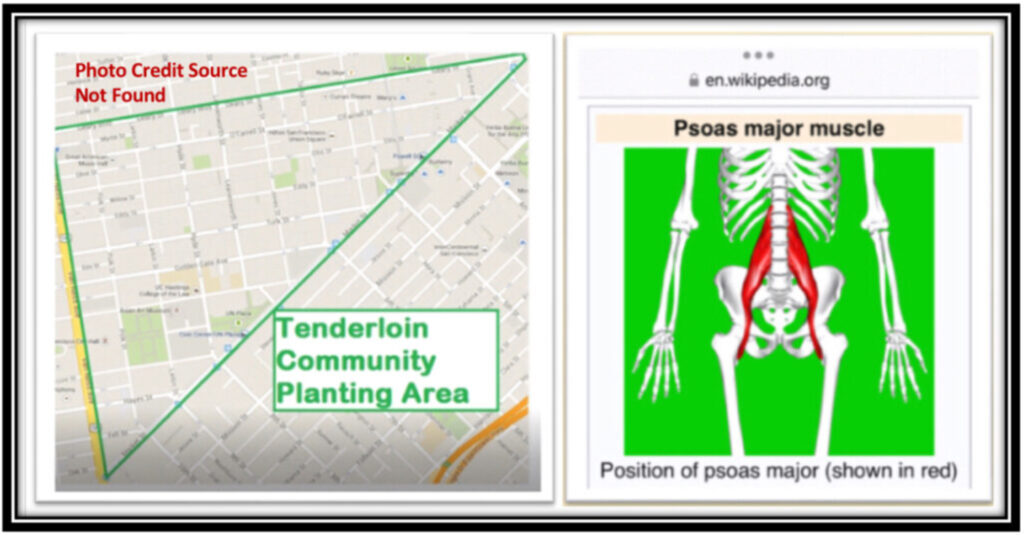When my daughter learned that Tenderloin Touch® was the name I had chosen for my massage therapy practice, she said, “It sounds like the name of a butcher’s shop.” And I suppose it does to someone who doesn’t know the story behind it. But before I explain, I must first tell you how a San Francisco city district dubbed, The Tenderloin, got its name back in the 1890’s. Below, I have listed the top five historical accounts as told by journalist, V. Alexandra de F. Szoenyi in her article, Tenderloin: What’s In A Name?
1.) The Shape Theory
Szoenyi tells us, “This is the most literal of all the theories.” On the map, the district’s outline resembles “an actual tenderloin cut of beef.” Interestingly, I also noticed that the human tenderloin, a muscle known as the psoas major, is comparable in shape. And that made me think of sacred geometry which one of my massage therapy instructors frequently referenced. Wikipedia once said this term is “based on geometries intended to make the viewer see the world through mathematics, and through this understanding, gain a better understanding of the divine.”


2.) The Copy Cat Theory
Szoenyi tells us that the law enforcement of San Francisco is thought to have imitated Captain Alexander S. Williams, who, in 1876, nicknamed a ruckus-making NYPD precinct, The Tenderloin. To this day, as shown in the below reels, San Francisco‘s version of the district is still making a lot of noise both on its streets as well as in the media and news outlets.
3.) The Dangerous For Your Health Theory
Local lore says that back then, law enforcement officers could afford the premier cuts of beef because they were well-compensated for working in this hazardous zone which was and still is a district of vice. Also, because of the bribes collected by turning a blind eye towards crime, officers could afford fillet mignon which is derived from the tenderloin. Indeed, Diamond Jessie, along with the other local madams, budgeted for hush money. Jessie’s house, though, was for the clubmen and the elite. Thus, she rarely had to give bribes. But that’s a different story.
4.) The Soft Underbelly Theory
The above clip depicts the streets of the Tenderloin district. The raw filth and sewage that fills the Tenderloin’s streets, might make a person pause to wonder about Szoenyi’s revelation of the next theory. She says, “The tenderloin is the most tender, and most often most expensive, cut of beef.” She continues, “Some believe the TL is so named because it was the ‘soft underbelly’ of vice in San Francisco.” Interestingly, Mark Latia, who first worked primarily with the residents of skid row, named his creative work and social media channels, Soft White Underbelly.
5.) The Prostitutes Theory
So what does filth, suffering and utter chaos have to do with the most tender and most expensive cut of steak? And how is it related to a tenderloin-shaped district filled with prohibited but oh so desirable vices? I will get into the meat of the answer in the next entry. But for now, let me just say that the last historic theory is associated with a highly sought after vice, prostitution. Supposedly, the term, Tenderloin, was originally slang for the tender and presumably supple loins of the prostitutes, (his, her’s and their’s) whom were many within the area.
6.) The pSOaS Messenger Theory
This sixth theory is not exactly one of the historical accounts which Szoenyi retold. In her first theory, the shape theory, I pointed out how the resemblance is not only to the cow’s tenderloin, but also to that of the human. The psoas is the deepest and most tender muscle. Many new age philosophers and body workers refer to the psoas as the muscle of the soul. So could it be possible that more than a hundred years ago, someone understood both the literal and the metaphorical definition of the tenderloin? After all, the Tenderloin of SF is the soul of the city.
Tenderloin Or Tempeh?
Speaking of steak, I’ve been a vegetarian for many years. Mostly, I’m vegan. I sometimes think something like this next story is what some carnivores imagine when I say I don’t eat meat or cheese. It’s about the time some animal rights activists tied to abolish the name of the soul district. The details are recounted in the article, Why is the Tenderloin called the Tenderloin? It was written by an author whose handle is 285 Turk Street.
The author tells us the district’s name is here to stay. They write, “In 2011, the People for the Ethical Treatment of Animals (PETA) attempted to persuade then-mayor Edwin M. Lee to rename the neighborhood as the Tempeh District . The proposed name would refer to a soy-based meat substitute rather than a butcher’s cut. The measure didn’t work.” Writer, 285 Turk Street, quotes The New York Times, “Like any pragmatic soul, Lee decided that it would be more productive if the conversation focused on revitalizing [the Tenderloin], not renaming it.”
I concur. By the way, I don’t eat meat mostly because it bothers me emotionally and psychologically. I don’t understand why it is a crime to kill a bird because it is the national emblem but okay to hunt the one that represents Thanksgiving. Of course, I do understand why it is a crime to kill an endangered species. But I don’t see why the humans who eat pigs will kill themselves to win the affection of a cat who is cold and distant. I don’t understand why we call cows beef and pigs pork as though renaming them de-animalizes them so they can be thought of as just food.
Don’t misunderstand, I do not think it is wrong to eat meat and I do not think vegans have a superior diet.
I will go through the McDonalds drive-thru and pick up for you all the nuggets or Big Macs you want. I understand the circle of life and I also know that plants are conscious. I do not think a vegetarian or vegan diet is better, less cruel, or more evolved. It is just what feels the least cringe for me for right now. Remember my mantra. To everything there is a season. So, if you thought the Tenderloin Tribe was made up of a bunch of a people who like to eat filet mignon, you still could be right. But the bigger truth is that we are the steak, baby! We are the tenders.

